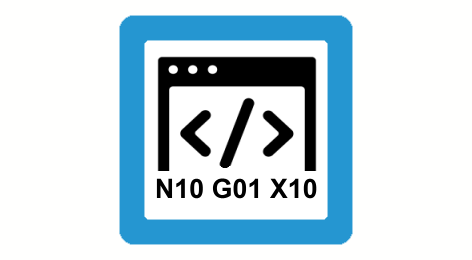Transformation of PCS positions (#TRAFO PCS ON/OFF)
Function available as of V3.1.3110.
Notice

The use of this feature requires a license for the "Transformations” extension package. It is not included in the scope of the standard license.
Syntax: | |
#TRAFO PCS ON | Selection |
#TRAFO PCS OFF | Deselection |
The #TRAFO PCS ON/OFF command enables and disables a transformation of the programming coordinates. The transformation data is defined by the configuration parameters trafo_pcs.type (P-CHAN-00829) and trafo_pcs.param[i] (P-CHAN-00263).
In addition to Cartesian and kinematic transformations, it is also possible to add this transformation as a topmost additional programming coordinate system on top of Cartesian transformations. These transformations map the programmed coordinates in the NC program based on their transformation type and only then are these positions mapped using the Cartesian and/or kinematic transformation.
The only difference to the #TRAFO ON/OFF command is the input and output positions of the transformations. Conventional machine kinematics programmed with #TRAFO ON/OFF are applied after the Cartesian transformations and have a physical relationship. The transformation activated here acts directly on the positions programmed in the NC program and represents more of a mathematical mapping.
The figure below shows the individual levels of the position in the CNC transformation chain. The programming coordinate system formed by #TRAFO PCD bears the fixed name of TPCS. The is always placed on top of the coordinate system last activated by #CD ON or #CD SELECT: A configured TRAFO PCS transformation can also be used in the calculation function #TRANSFORM.

Programing Example

#TRAFO PCS ON / OFF
;Condition:
;trafo_pcs.type 212 axis coupling transformation
,master axis is Z, slave axis C, coupling factor 0.5
N10 #CS ON [0, 0, 20, 0, 0, 0]
N20 G01 F1000 Z100 C0 ;Z-ACS-Pos=120 C-ACS-Pos=0
N30 #TRAFO PCS ON ;select PCS transformation
N40 G01 Z200 ;Z-ACS-Pos=220 C-ACS-Pos=50
N50 #TRAFO PCS OFF ;deselect PCS transformation
N60 G01 Z100 C0 ;Z-ACS-Pos=120 C-ACS-Pos=0
N70 M30